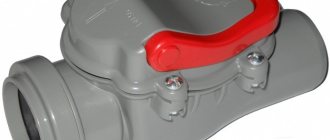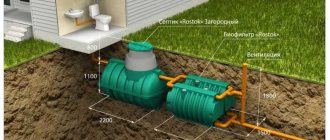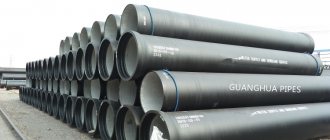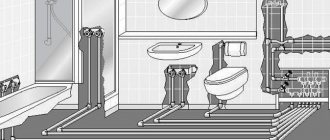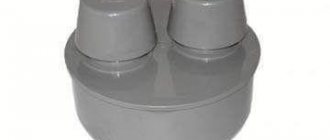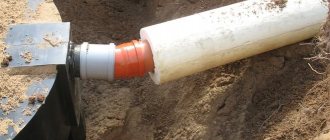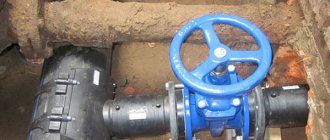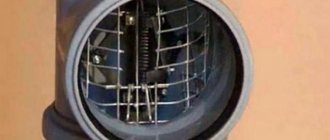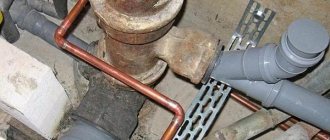When designing sewer lines, a number of mandatory requirements are observed for their normal functioning. One of the main conditions is the presence of hydraulic valves in the connected plumbing fixtures. It is useful for any owner who lays a pipeline for drainage with his own hands to know what a water seal for sewerage is - this will allow him to avoid installation errors and ensure reliable operation of the system.
Typically, a water seal is provided by plumbing siphons, sold in a wide range in the retail chain; they differ in design and dimensional parameters, some products have built-in additional elements. To choose the right device correctly, if it is not supplied complete with sanitary equipment, take into account the scope of application, design features of siphons, and their installation technology.
Rice. 1 Siphons under plumbing fixtures
Purpose of a water seal for sewerage
The sewer water seal performs the following functions in the system:
- Prevents unpleasant odors from sewer pipes from entering the room.
- Reduces noise when draining waste water streams.
- Blocks the entry into the home of explosive gases (ammonia and methane), which are formed during the decay of organic waste.
- During a fire, it cuts off the siphon units of plumbing fixtures from the general sewer line.
- Performs the functions of a garbage collector, accumulating various types of waste at the bottom of siphon devices.
- Prevents bacteria, various types of microorganisms, and insects from entering the premises through sewer pipes.
Rice. 2 The operating principle of water seals in toilets and siphons
Water seal for storm drainage ↑
Baths, showers, swimming pools, rooms where spills of large amounts of liquid may occur, and even outdoor areas near the house require special sewage systems that ensure drainage of wastewater flows.
Sewage receivers located at the conditional floor level are called storm drains or drains, which mainly differ only in performance.
Photo: drains and water seals for storm sewers
Storm sewer receivers mainly have a balloon structure, i.e. to ensure the minimum size of the siphon for the water seal, a small cylinder is located in a large cylinder-housing to form a sewer channel.
Storm drains are “sensitive” to debris, and cleaning them is a frequent occurrence, and their design takes this need into account, so disassembling the drain is done in one motion - removing the grate cover.
Find out how much it will cost to install a water meter from the article: installing water meters yourself. How and from what materials you can make a bath mat with your own hands, read here.
The article describes the types of wall-hung toilets with a bidet function.
Features of the device and principle of operation
A hydraulic valve is a structural element of a pipeline that constantly contains water. A water plug separates the drain openings of sewer appliances from the pipes - as a result, foreign odors from the sewer do not penetrate into the room.
To install a water seal, two main methods are used.
In the first case, the pipeline is bent or a separate element is installed, giving it a U-shape - here the water seal is the water collecting in the lower part of the bend. In another method, the drain pipe of plumbing fixtures is lowered into a deep glass that has a side branch - in this case, the water seal is a water column collected in the lower part of the glass body.
When draining water from plumbing fixtures, the water plug is always renewed - thus, there is no long-term stagnation of water in the water seal, which leads to the appearance of moldy odors.
What causes the water seal to break?
Sometimes the water seal breaks. There are several reasons for this.
- Significant pressure drops within the sewer system. As a result, the water plug may be squeezed into the water inlet. Sometimes air from the sewer gradually penetrates into the room.
- Vacuum in the pipeline. This situation is possible when a large amount of water flows from the water intake into the system, completely blocking the lumen of the pipe.
The second situation occurs when the norms provided for by SNiP are violated:
- incorrectly selected pipes (too small a diameter that cannot cope with water flows);
- failures in the slope of horizontal lines that appeared after repairs;
- the occurrence of blockages or icing, leading to a narrowing of the lumen of the pipes.
Advice! Sometimes in corrugated models, dirt accumulates at the bottom of the siphon, which causes an unpleasant odor. To avoid such developments, you need to use additional meshes for the sink.
Types of sewer water seals
On the plumbing equipment market you can purchase both a ready-made water seal for the sewerage system and various elements from which it is easy to assemble it yourself. The consumer usually uses two or three types of hydraulic locking units, the remaining modifications are intended for use in specific conditions.
Rice. 3 Knee siphons
Knees for bath
In appearance, knee models of hydraulic valves resemble the letter U; the unit is characterized by a simple design and high strength. The main installation locations for U-shaped elbows are under the bathtub; in the toilet, a similar water seal is built into the structure.
There are several types of elbow siphons, some models are designed for rigid and durable installation in the pipeline and have a design in the form of one elbow with union nuts, others consist of several parts that allow precise adjustment to the inlet and outlet pipes.
Knee siphons can be made small in height, unlike bottle siphons - this expands their scope of application from sinks to installation under bathtubs that have a low drain pipe. The disadvantages of the devices include inconvenience in maintenance - in order to remove dirt and debris that has settled to the bottom, you have to completely dismantle the device.
Rice. 4 Construction of bottle siphons
Bottles for sinks
Structurally, they are made in the form of a cylindrical settling body with an upper and side outlet, which has a screw-on lid at the bottom. During operation, water enters through the inlet pipe into the volumetric flask, and after filling it, it pours out through the side outlet - the water seal provides the liquid remaining in the flask of the device. The design allows you to collect all the dirt from the sinks at the bottom of the flask and periodically remove debris by unscrewing the lower cap; if heavy objects have fallen into the sink, it is easiest to get them out of the bottle body.
Due to ease of maintenance, bottle siphons are installed under kitchen sinks and washstands in bathrooms, where there is enough space under the sinks to accommodate their rather voluminous and vertically elongated body. The disadvantages of siphons of this design include the impossibility of cleaning the sewer pipeline with a plumbing cable through their body - the device must be dismantled, freeing the pipeline, after which the necessary work is carried out.
Rice. 5 Types of siphon corrugations
Corrugated S-shaped
One of the simplest and most universal options for organizing a water seal is to use a piece of flexible corrugated pipe, which is bent in the shape of a U, like an elbow. When the outlet pipe of the corrugation is lowered down, an S-shape appears.
The corrugation is good for its versatility - the bend can be made in any convenient place, it is easy to connect to the drain hole and sewer pipe at any relative location and distance due to the ability of the corrugated shell to stretch and easily change its direction. A plastic holder is included to keep the shape unchanged.
The main disadvantage of a corrugated water seal is the high hydraulic resistance to water flow and the ribbed inner shell, in the grooves of which dirt accumulates intensively.
Rice. 6 Overflow siphons for shower bowls - design
Overflow for shower cabins
A distinctive feature of all shower cabins is the rather small distance of the specially designed drain hole from the floor - this imposes certain requirements on the siphon unit. Structurally, many siphons for shower cabins are made in the form of a low cylindrical body into which a removable glass is lowered. Water enters the glass through a pipe with a lid lowered into it, and after filling it pours through its walls, which have side holes or the height of the upper edge below the siphon body.
If any debris or small valuable items get into the shower tray, they can be easily removed by removing the cover along with the inlet pipe and pulling the glass containing the items out of the siphon assembly. The designs of overflow shower siphons are quite varied; they are all united by a round chrome-plated lid, which provides a side drain and is comfortable to stand on, as well as a low body.
Rice. 7 Parts of the shower overflow siphon
Bath drains
In bathhouses, steam rooms and saunas with a shower, in places where stormwater accumulates, water collects from a large area, so to bring it to the drainage point, the floor is made with a slope, and a drain is placed in the center. The standard device is a small-volume chamber into which water enters through the upper grill and pipe, after which it overflows through its edges or upper outlets and then follows the pipe.
The design is in many ways similar to bottle-type siphons, but does not have a lower removable lid for removing debris, since the body of the device is placed (walled up) in a screed. Dirt usually collects in the inner cup, which is easily removed from the device body.
Rice. 8 Operating principle of drain valves
Water seal in the sewer system
What is a water seal in a sewer system and why is it needed at all?
Effective operation of the sewer system is a prerequisite for normal living in the house.
There are no trifles in this matter; the slightest mistake will lead to a deterioration in the operation of the system. One of the conditions for the absence of odor from the sewer system is the presence of water seals. In addition to water seals, there is also a dry water seal for sewerage. Let's figure out what it is. The sewage system is designed to remove liquid waste from premises, including waste products. It is clear that the inside of the system does not smell like roses, so it is necessary to provide protection against the penetration of these unpleasant odors into the house.
A water seal is a reliable protection against unpleasant-smelling gases. Let's figure out what it is and what designs can be used in the sewage system of residential buildings.
Description
A water seal is a water plug that is constantly located in the pipe, preventing sewer gases from entering the premises. A water seal is required when installing any plumbing fixture connected to the sewer network.
The presence of a water seal does not interfere with the passage of wastewater; the water plug is renewed after each use of the plumbing fixture. But if there is no one at home for a long time and, accordingly, no one uses water, then the water plug can dry out and gases from the sewer pipes will easily penetrate into the room.
However, it will not be difficult to restore the water seals; it is enough to open the water so that the water plug will form again.
Kinds
The structure for creating a water seal is called a siphon; it can have a different design. Most often used:
- Bottle - a universal option, suitable for any type of plumbing;
- Tubular - smooth or corrugated, used for kitchen sinks and washbasins;
- Drains are a special type of siphon used in shower cabins, as well as in the washing rooms of baths.
In addition, there are dry siphons in which, instead of a water plug, a membrane is used that acts as a check valve. Such a shutter is good because it will restrain the movement of not only gases, but also liquids.
The use of such equipment is especially recommended in apartments located on the lower floors of multi-storey buildings. It will prevent the flow of wastewater coming from the upper apartments through the plumbing when a blockage forms in the sewer pipe. Let's figure out what types of siphons exist and what features of installing this sewer element with your own hands exist.
Bottle
The bottle siphon is often used to assemble sewer systems. The device has a specific shape; the device consists of a sump and a flask. There is always water at the bottom of the siphon, creating a water seal.
Previously, bottle siphons made of cast iron were installed in almost every apartment, which were connected to a cast-iron sewer pipe ; now they have been replaced by analogues made of polymer materials, and polypropylene sewer pipes . It is extremely rare to find elements of a sewerage system made of brass.
To connect two drains at the same time, a unified bottle-type siphon can be used. This option has a curved pipe that connects to a tee with connected outlets from the plumbing elements.
You need to choose a siphon taking into account its throughput. The more elements you plan to connect to the siphon, the more productive the model should be. The main advantage of this model is that it can be easily cleaned without disconnecting the siphon from the sink.
The presence of a sump in the siphon allows you to save valuables (for example, jewelry) that could accidentally end up in the sewer system. In addition, the bottle-type siphon has a rigid structure, so it will last longer than models made from corrugated pipe. Also, usually the manufacturer includes o-rings
.
Tubular
A siphon is made of a smooth or corrugated pipe, which is bent so as to form a kind of “loop” located below the main pipe in level. The water plug will be located in this “loop”.
Smooth tubular siphons are rarely used, since a regular pipe is difficult to bend, and in addition, this model takes up a lot of space. Therefore, in most cases, a corrugated pipe is used to make a siphon. It is easy to bend a corrugated pipe in the desired direction; the finished siphon takes up minimal space.
The option has the following advantages:
- easy to assemble by yourself;
- The model has a universal purpose; it can be installed with any element of plumbing, including a toilet. In the latter case, a corrugated pipe with a diameter of 110 mm is used;
- if necessary, you can easily adjust the length of the siphon loop, even if the system is already installed and connected;
- you can remove and move (short distances) the sink without disconnecting the siphon from it.
Ladder
Compared to a conventional siphon, the drain has a more complex design. This element is installed in the shower tray or directly in the floor covering. Full range of work on ladder installation:
- connecting the drain to the sewer outlet;
- performing thermal and waterproofing;
- production of concrete screed with a slope towards the ladder;
- laying moisture-resistant coating.
Ceramic tiles are most often used as a moisture-resistant coating.
This material is not afraid of contact with water and is easy to keep clean. If a regular siphon should only provide water drainage, then the drain performs additional functions:
- ensures tight connection to the floor;
- provides preliminary filtration, preventing large contaminants from entering the pipe.
In addition, the drain, like a regular siphon, creates a water seal, which prevents the penetration of unpleasant odors into the room.
Dry option
The dry seal for sewerage has more advanced characteristics than traditional water seals. This model has a different operating principle; it operates according to the nipple principle. The device is made in the form of a polymer tube with threads on both sides. Polypropylene is most often used to make the model.
Inside the housing there is a special membrane that prevents the reverse movement of water and sewer gases. That is, the membrane performs the functions that a water plug performs in a conventional valve.
Dry seals are not recommended for installation with kitchen sinks and dishwashers. Otherwise, the shutter will quickly fail.
If a conventional valve ceases to perform its functions during prolonged inactivity due to the water drying out, then the dry version will function normally under these conditions.
Pros of the option
Advantage of the option:
- the device does not require water supply for normal operation;
- the model can be installed even in unheated rooms, since there is no threat of destruction due to freezing water. This option is suitable, for example, for a summer cottage that is not used during the cold season;
- dry siphons are compact and convenient;
- it is much more difficult to break a dry seal than a water seal;
- eliminate the backflow of dirty water, which can occur when a blockage forms;
- the shutter can be installed both vertically and horizontally;
- water does not stagnate in the shutter, in which harmful bacterial flora can develop;
- has excellent sound insulation;
- has a long service life.
Types
Dry seals are available in several versions, each of them has its own characteristics. Here are the most common options:
- Membrane. This is the simplest and most common option. The valve operates due to a spring membrane, which opens when water flows from the drain hole, but remains closed until the water is used.
- Float This option can be called transitional between dry and water seals. The device is equipped with a float valve. When liquid enters, the float floats up so as not to interfere with the liquid leaving. And after the water leaves, the float falls into place, sealing the lumen of the sewer pipe.
- Pendulum. The valve in such a valve has a single attachment point. When water enters the drain, the pendulum deviates, opening the passage. Then, under the influence of gravity, the valve returns to its place.
- With molecular memory. This is a high-tech option; such shutters are quite expensive. Thanks to new technologies, membrane elements reliably seal the pipe lumen after water stops flowing into the drain.
So, there are different options for water seals for sewerage. The choice of option is made depending on the type of plumbing element, as well as operating conditions. Installation of water seals is a prerequisite for assembling an internal sewerage system. If they are missing or installed incorrectly, an unpleasant sewer smell will certainly appear in the apartment.
Dry water seals
The need for dry water seals is caused by one of the disadvantages of wet ones - they constantly contain water, and if it is not changed, it begins to smell bad, microorganisms, mold, and algae can appear in it. Therefore, the installation of dry water seals is relevant in places where water is used at long intervals - baths, saunas, shower rooms and similar rooms.
There are several types of dry water seals, differing in their operating principles, the main ones being:
Float A sewer drain with a float-type water seal is one of the most popular models. The typical design is an inverted lightweight glass, the edges of which are immersed in water located between the drain body and its central drain pipe. Water enters the interior of the body through a cover that protects the inverted float; after using the shower, it gradually dries out, the float sinks to the bottom and blocks the drain hole with its body.
In other designs, instead of a float, a light ball is used, which, after the water leaves, is lowered into the outer seat and hermetically closes the drain hole.
Rice. 9 Operating principle of the float siphon
With check valve . The operating principle of the design is based on the fact that the drain channel is closed by a valve on curtains (pendulum design) or in the form of a spring-loaded nipple. When using water, it opens the valve under pressure and pours into the pipes; as soon as the water is turned off, its pressure on the locking element drops, and it mechanically closes the drain channel.
Membrane . One of the latest developments is a dry water seal for sewage with a silicone insert. Its difference from analogues is that it is detached from drains, sanitary equipment and other elements of devices due to the possibility of use anywhere in the pipeline.
This is achieved by a design that is a short piece of pipe, inside of which a silicone membrane is placed in the form of a short sleeve. Its direction is indicated on the body of the device by an arrow; when turned on directly, water passes freely through the hose under its own pressure; in the absence of direct water flow, the walls of the hose are compressed and do not allow the liquid to flow back into the channel. Similar products are supplied to the domestic market by foreign manufacturers in standard sizes 32, 40 and 50 mm. The advantages of the devices are that they can be located vertically or horizontally in the pipeline.
There are other models of membrane valves that are mounted directly into the drain in a vertical position; they operate on the principle of a check valve, opening under water pressure and closing the channel after it leaves.
Rice. 10 Types of dry membrane hoses
Device ↑
There are several types of water seals:
- bottle designs are based on several hydraulically connected cylinders, inserted one into the other and holding a liquid level that creates a seal against the penetration of gases. Such water seals are popular in the design of siphons for washbasins and bathtubs, because... there is a constructive possibility of connecting an additional outlet of small cross-section, which is connected to the overflow system;
Photo: bottle water seal
Drains are made using the principle of a bottle siphon and are installed in the floor or shower trays.
- A double-turn water seal has two counter-mounted elbow connections of a sewer pipe, due to which a “pocket” is formed to hold the liquid that performs the function of a water seal. Elbows can be made from either a rigid pipe or a flexible one (corrugation);
Photo: simple water seal
Similar channel water seals are available on toilets and simple siphon systems.
- dry water seal for sewerage is a special type of siphon that combines a classic water seal and a sewer check valve. The design of the device is based on a spring-loaded damper, which opens the sewer passage, moving under the resulting pressure from draining the liquid. And in the absence of a water column, the damper closes the sewer pipe due to the force of the spring.
Photo: dry water seal
There are designs where there is no spring on the valve, and its movement is carried out only under the influence of its own weight.
Modern sewer systems are subject to strict requirements for the unhindered passage of wastewater, which is only possible if the internal surface of the pipes is sufficiently smooth and chemically reactive and their cross-section is not overgrown.
That is why different types of polymers have become the main material for the manufacture of sewer systems. Moreover, even powerful reinforced concrete or ceramic sewer collectors have an internal polymer layer.
In addition to polymer sewer systems, there are siphons made of stainless steel, brass or old, but time-tested, cast iron.
Photo: brass siphon steel siphon
Reasons for failure
The water seal of the sewerage system is a structurally simple product that does not contain complex elements, so its failure occurs quite rarely. The following situations arise most often:
- A water seal failure in a sewer occurs when the pipe in an apartment in a multi-storey building, a cottage, or in a country house along the riser above is closed or clogged. In this case, when large volumes of water are drained, the vacuum formed in the riser pipe carries water from the water seal with it, and it opens. This problem can be eliminated by cleaning the riser pipe or installing a vacuum valve at its end.
- Blockages are the most common cause of failure of water seals; dry operating devices are especially susceptible to this disease. If debris gets under the lowering float or into the closing sleeve of the membrane, they cannot close and foreign odors enter the room.
- Improper installation is another reason why water seals malfunction. Failure to observe slopes in pipes, spontaneous straightening of corrugations, and violation of the assembly sequence of complex systems leads to incorrect operation of locking devices.
- Leaks can also cause water seals to fail. A situation that often arises is that water flows out of the bottle elbow through a poorly screwed sump lid at the bottom.
Rice. 11 Types and cost of siphons for sinks and bathtubs
Storm drains
Stormwater inlets are designed to drain rainwater from the roof of a building. The drainpipe, going down from the roof, enters one section of the storm drain; the second section serves as a water seal and, in turn, is equipped with a mesh for collecting debris. Storm drains are made of impact-resistant polypropylene, resistant to any weather conditions. The presence of all kinds of outlets for sewer pipes, including adapters (round, square) for any standard size of drainpipes makes our storm water inlet a reliable assistant in solving the problem of draining rainwater from the roof.
Features of choosing a water seal
The most important thing when choosing is to purchase and install a water seal that matches the purpose of the device. That is, bottle-type appliances are installed in the kitchen, U-shaped appliances are installed under the bathtub, appropriate low-height products are installed in shower cabins, and drains specially designed for these purposes are installed in floor screeds.
When choosing a suitable model, we are additionally guided by the following considerations:
- In no situation should you install a corrugated water seal in the kitchen, despite the ease of connection - dirt will always accumulate on its walls, preventing drainage. This will lead to the need for frequent sewer cleanings, spending financial resources on the purchase of various chemicals or plumbing cable for cleaning work, the price of which is much higher than the difference in cost between a cheap corrugation and a conventional siphon.
- Before purchasing siphons for a bathtub, you should be especially careful - not every model is suitable for installation under a bowl due to its vertical dimensions. Therefore, you should first measure the distance from the drain to the floor, and then select the desired modification. This also applies to the choice of shower siphons, if they are not included in the package.
- When the water seal in the system often breaks (the situation can arise in an apartment building or private building if the sewer riser is clogged at the top), purchase a kitchen siphon with a built-in vacuum valve.
Rice. 12 Siphons for shower cabins and drains - prices
Installation features
Homemade shutters turn out to be quite large. There are no problems with placement under a washbasin or kitchen sink.
If we are talking about a shower stall or bathtub, then it is better to provide for the installation of such an element in advance - before installing the floors in the room where it is planned to install this sanitary fixture.
Since domestic sewerage is gravity-fed and there is no excess pressure in it, there is no need to use strong threaded connections sealed with tow or fum tape. Typically a socket connection with a rubber O-ring is used.
Such a connection can be sealed using sealant (silicone) and metallized tape intended for pipe repair.
If you don’t have any suitable materials in your workshop, you can use the “old-fashioned” method: tow is wound around the pipe inserted into the socket, and after installing the part, the joint is sealed with cement mortar.
How to install
Any siphon purchased in a retail chain has an instruction manual, which details the order of its assembly according to the drawn diagram, so a detailed description of the process of connecting various parts does not make sense. Installing a standard siphon (Fig. 13) in a bathtub consists of the following steps:
- On the floor, according to the instructions, connect the elements of the U-shaped sump, screw in the inspection cover and the pipe, which is attached to the bottom of the bath.
Important: The most important thing in this case, as in assembling the entire siphon, is the correct installation of the cone-shaped ring gaskets. The sharp end should fit into the joint of the parts being connected, and the wide end should be pressed with a union nut.
- Next, place a gasket in the drain hole of the bathtub, place the assembled unit underneath and screw it with a screw inserted into a metal cup with holes on the other side. However, do not apply too much force when rotating to avoid stripping the thread.
- Insert a pipe with a cup and a rubber gasket from the outside into the overflow hole at the top of the bathtub, screw it on the other side with a screw through a metal round grille.
- Next, connect the outlet pipes of the overflow bowl and the lower unit of the siphon with a double-sided corrugation; to do this, place cone-shaped rings on its ends and screw the corrugation with union nuts, pressing the wide edge of the gaskets.
- Insert a corrugation with a cone-shaped ring into the outlet hole of the siphon unit and press it with a union nut. The second end of the corrugation is inserted into the sewer pipe.
Rice. 13 Bath siphon - assembly diagram
Closures in the sewer system are the main way to get rid of unpleasant odors from pipes. For their installation, various types of siphons are sold in the retail chain. Each product is intended for use in a specific type of plumbing fixture, so the consumer only has to purchase the item for its intended purpose, assemble and install it according to the attached instructions.
Installing a water seal
The question often arises of how to install a water seal in a mash lid. If you need to carry out the fermentation process in a container with a neck, then auxiliary plugs for the shutter are purchased, which are installed on the neck itself.
The user will need to measure the diameter of the neck and select the size of the plug. The hydraulic valve is placed on top of a sealed container, and, thanks to a reliable rubber plug and a water layer in it, proper tightness of the fermentation container will be ensured.
In view of this, carbon dioxide, which is intensively released during fermentation, is carefully removed, and the penetration of oxygen into the container is prevented. The stability of the fermentation process and the quality of the alcoholic drink will also be ensured.
Fermentation tanks with a water seal can be purchased in parts or as a set. It is permissible to do some of the design elements yourself, but at the same time the safety of the process and the production of a high-quality product must be ensured. By following these recommendations, the user can, without much effort, make an effective device that will help follow the mash preparation technology.
How to make a water seal for mash with your own hands
There are several options, each of which is worth considering in detail.
Classic water seal
To make it you need a jar, a tube and a lid to close the container; sometimes it is imitated from a piece of plasticine.
You need to make a hole in the lid, insert a tube and seal the gap between them. To do this, you can use sealant, wax, plasticine or another similar product.
The second end is lowered into a jar filled with water and secured with electrical tape or string.
Important! If you use a tube of very small diameter, especially for a large container, it can become clogged with foam, so you should choose the diameter of the tube in accordance with the volume of the mash.
The main advantage of this design is the visibility of the completion of the fermentation process, which will be expressed in the disappearance of bubbles on the surface of the water.
This design can also be equipped with a gas outlet into the sewer or outside the window, which will eliminate the specific smell of fermentation. To do this, you need to make a lid on the jar of water, similar to the lid of the steamer. In this case, a jar is needed either with a thread for a lid, or a nylon lid for a regular jar; the ideal option is a steel lid with welded tubes.
Two holes are made, into one a tube is inserted through which carbon dioxide flows, it must be lowered under water, into the second - a tube through which the gas will be discharged to the selected location, both joints are sealed.
The big problem is to make a water seal for the mash on an aluminum flask, since there are only two options: either drill the lid, which will make it suitable for only one task, or make a replacement for it - a “stopper” made of wood - and drill a hole in it. To seal the seams around the circumference you will need a lot of plasticine.
Of course, you can cover the neck with thick polyethylene, secure it by wrapping it around the circumference with tape, and after making a hole in it, insert the tube. Then for sealing you will need liquid silicone or other sealant; plasticine will not work, and such a “lid” will have to be remade from time to time.
Glove
A very simple solution, which is not essentially a water seal, since a water plug is not used. An ordinary medical glove is pulled over the neck of the container. A small hole is made in one of the fingers to allow carbon dioxide to escape.
The point is that even after the first active days, when the gas begins to be released less intensely, there will still be enough of it to prevent oxygen from penetrating through the small hole inside.
At the beginning of fermentation, the glove swells strongly, over time it becomes weaker and weaker, and finally its fall indicates the complete completion of the gas evolution process.
Cotton plug
This is a last resort solution if a glove breaks or a jar breaks. The neck is plugged with tightly packed cotton wool or other porous material that allows carbon dioxide to pass through.
The effectiveness of this “design” decreases as the end of fermentation approaches and the release of carbon dioxide decreases, due to which oxygen begins to enter. Also, in this version, it is visually unclear at what stage the fermentation is.
From syringes
To do this, you will need two disposable plastic syringes, about 10-20 cubic meters each, depending on the volume of the container for the mash mass. The pistons are removed from them, and the bodies are tied to each other with electrical tape or adhesive tape with the noses facing inward.
One spout is connected to the other via a tube. All this must be done when one of the housings is already inserted into the lid that will close the container. Cutting a hole in the lid and sealing it with silicone or plasticine is not difficult. After the cap is placed on the neck, water is poured into the body of the upper syringe.
